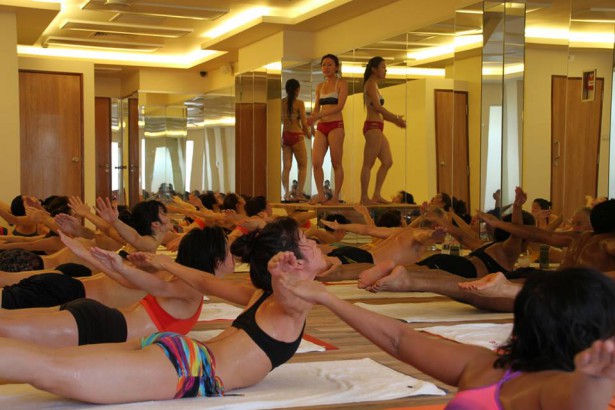Bikram Yoga: Health benefits and key poses
mis à jour le 7 October 2015 à 00:02
All you need to know about this challenging 'hot yoga' which may be daunting to some, but has tremendous health benefits.
Although originally popular since its inception in the 1970s in the West, Bikram Yoga has grown tremendously as a brand in recent years in Asia. Started by Calcutta-born Bikram Choudhury, the practice is considered the toughest of all the different types of yoga as it lasts 90-minute, is practised in a room heated to 40 degrees Celsius and consists of 26 postures repeated twice with 2 breathing exercises.
But what are the benefits of this extreme form of yoga? We ask Maria Lourdes-Chan, founder and yoga instructor at Bikram Yoga Katong, which happens to be Singapore’s ‘Hottest yoga studio’ – with temperatures ranging from 40 to 42 degrees Celsius.
According to Maria, the benefits are many. “The heat, the sequencing of the postures, and its consistency is what distinguishes Bikram yoga. The sequence was designed to move fresh, oxygenated blood to 100 percent of your body - to each organ and fibre - restoring all systems to healthy working order, just as nature intended. Proper weight, muscle tone, vibrant good health, and a sense of well being will automatically follow. Bikram yoga works by creating the tourniquet effect: stretching, balancing and creating pressure all at the same time. The blood supply in the arteries and veins is being cut off to create pressure in the body. When released, blood rushes through veins and arteries, flushing them out.
It is an amazing detox. The meditative aspect of the yoga allows one to achieve what philosophers refer to as self-realization.
With regular practice, people also start to realize that the yoga helps them achieve peace of mind and begin to discover that there are transformative benefits in that area as well.”
Another instructor, Jill Alphonso, adds “The main idea of the yoga is that you try the posture the right way, never modifying the pose to suit your body, but rather moving into what your body can do.”
Tempted to give it a shot? We pick 5 specific poses from the practice as Jill tells us a little bit about each of their benefits:
1) Standing Bow Pulling Pose (Dandyamana Dhanurasana):
Though challenging, this pose is one of balance, strength and flexibility. The key is to kick upwards while stretching forward, with the aim of getting two feet in one line from the side - eventually you'll be in a standing split. The body has to be down, with the abdomen and chest parallel to the floor. The benefit of the pose doesn't sound very sexy but it is essential - it moves the blood from one side of the body to the other, circulating the blood to each internal organ and gland. While in the pose, it almost feels like you're dancing, and though it's natural to fall out, you learn something about your own strength and willpower.
2) Triangle pose (Trikanasana):
This posture works every single muscle, joint, organ, tendon, and gland in the body. It is the apex - the master pose of the standing series, and strengthens the spine. It increases the flexibility of the hips, and firms the upper thighs while firming the waistline, arm and shoulder muscles as well. It looks a lot like the "warrior" pose in other yoga schools of thought, and it certainly feels like you've got to channel a warrior spirit in order to get through it. It's a tough one, and the heart rate spikes during this pose.
3) Standing Head-to-Knee Pose (Dandayamana Janushirasana):
First-timers in class look at this posture with horror in their eyes. You're balancing on one leg, and in the final expression of the pose, you've got your back rounded, elbows bent below the calf muscles, staring at your naval and with your forehead to your knee. It feels as though you are going "into" yourself. Out of all the postures, this one demonstrates the "mind over the matter" concept the best. You think you can't, but you can - and in order to get to the final expression of the posture, you must make up your mind that you can do it. This pose is achievable with the utmost willpower and determination - and with a good dose of what Bikram calls "English bulldog determination, Bengal tiger strength". Physically, it tightens the abdominal and thigh muscles, as well as the hamstrings.
4) Locust Pose (Salabhasana):
This one is powerful for curing back pain. It also brings fresh blood flow to the elbows, wrists and hands, helping with arthritis and carpel tunnel syndrome. The third part of the pose, which has you raising both the legs with your arms under you, is the most challenging part of the posture, and requires an immense amount of upper-body and upper-spine strength.
5) Camel Pose (Ustrasana):
Some people think of this one as the "heart-opener". It's the deepest compression of the spine that has you arched backwards, opening your entire throat, abdomen and chest areas to the world. Your head is dropped back, and you're essentially upside-down. The trick is to breathe while in the posture. All postures in the Bikram series ask you to move the body in a perfectly natural way. In this one, we're not used to backward-bending, and it can feel pretty scary, and the heart rate rises. Breathing through the pose, and breathing after it, helps you master your breath, and your emotions.
Diya-Maya Tsering Bhalla



